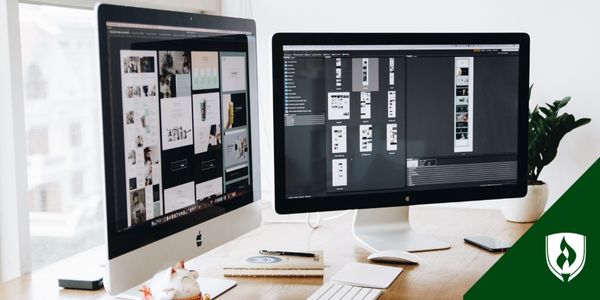Should I Be a Graphic Designer? 6 Questions to Help You Find Your Answer
By Callie Malvik on 04/05/2021

Whether it’s the collection of pamphlets you browse through while waiting for your dentist appointment, a fascinating graphic that attracts your attention while scrolling through your social media newsfeed or that billboard promoting the new restaurant in town, you are constantly surrounded by visuals designed to grab your attention and communicate a message that sticks in your mind.
Perhaps you often find yourself evaluating those designs—wondering if a different color combination would have been more appealing or an alternative layout could have better highlighted the most important information. Your innate creativity and eye for detail may have you thinking, “Should I be a graphic designer?”
These natural characteristics could make you a perfect fit for this field. But there are a few more qualities that great graphic designers share. Keep reading to find out if you have the makings of a prolific designer. Check out skills you need for graphic design.
Should you become a graphic designer? 6 Questions to ask yourself
When considering something as important as pursuing a career, a little introspection goes a long way. Take the time to consider the following questions.
1. Am I versatile?
Graphic designers are often tasked with juggling many different projects at once. This is especially the case if you choose to work in an agency setting, representing a handful of different clients or brands. Even in-house designers often find themselves working on all sorts of diverse projects—from website banners and social media images to sales sheets and print catalogs.
For those who choose the freelance-designer route, this list of responsibilities goes above and beyond design work. You’ll also need to manage your marketing, accounting, client relations and more. Regardless of which graphic design work environment you end up in, being adaptable and able to multi-task is essential.
2. Do I embrace change?
The world of graphic design is constantly evolving. New techniques and technologies are introduced every year, which is why a commitment to lifelong learning is key to building a lasting design career.
The exponentially growing and transforming world of technology has an enormous impact on the graphic design field. Are you excited to learn about the latest features in design software? Will you make time to learn about a new technique that will make managing your workload more efficient? If you tend to resist change, you might want to consider a different career path.
3. Am I patient?
Much of a graphic designer’s work comes at the direction of a client or other internal stakeholders. There will rarely be a project where you’re given free creative reign and not encounter any requests for revisions along the way. You can expect to spend time dealing with hard-to-interpret feedback and clients whose priorities may shift mid-project.
While there are ways to maintain positive communication between you and your clients, you will still need to be patient as a designer. Every client and project is different, and they all can end up requiring multiple revisions and changes before everyone is satisfied.
4. Am I a team player?
It’s true graphic designers spend a good amount of their time working solo as they create new materials, but production time is only a portion of the job. The rest of their work relies heavily on collaboration. It’s import to be able to negotiate ideas and concepts with a client as well as with your own team members.
At any given point in your career, you could find yourself collaborating with various developers, working with another designer on a project or leading a group of fellow designers. This means you’ll need to balance the desires of your clients and coworkers while asserting your own professional opinion on how a project would be most visually appealing. This can be a challenge considering graphic design is a subjective field. You’ll need a bit of diplomatic tact and a willingness to listen, even if you disagree.
5. Can I handle a little criticism?
Speaking of subjectivity, it’s inevitable you’ll eventually come across an opinion that differs from yours. As a graphic designer, it’s imperative that you don’t take feedback personally. This can be easier said than done—especially if you’ve poured your heart into a project. But in the end, you ultimately need to respect the client’s wishes and work to reach a compromise.
As a graphic designer, your ideas and designs will always be out there for others to see—and with that comes criticism. This can be both good and bad. Thoughtful, constructive criticism can lead to professional growth if you’re willing to accept it. The key is to keep an open mind and take criticism in stride.
6. Am I a problem-solver?
Chances are good you're used to solving problems, whether that's in your current job, personal life or as a parent. Problem-solving won't end in your career as a graphic designer. Your job as a graphic designer is to find the most effective way to achieve the objective at hand.
Some requests will be more challenging than others. If you have a mindset that perceives problems as exciting opportunities, you will probably be successful in meeting your client’s requirements even if it takes multiple attempts and edits.
Is becoming a graphic designer in your future?
The next time you see an eye-catching billboard or an attractive-looking website that has you thinking, “Should I be a graphic designer?” think back to these questions. Your natural creative flair can take you quite a ways, but the traits outlined above can help you take your career to the next level.
Seriously considering this creative career? Discover the ins and outs of the graphic design field in our article “What I Wish Someone Had Told Me BEFORE Becoming a Graphic Designer.”
EDITOR’S NOTE: This article was originally published in 2017. It has since been updated to include information relevant to 2021.




